Murakami, Niigata
Murakami (村上市, Murakami-shi) is a city located in Niigata Prefecture, Japan. As of 1 December 2020, the city had an estimated population of 58,300 in 22,594 households,[1] and a population density of 50 persons per km². The total area of the city was 1,174.26 square kilometres (453.38 sq mi).
Murakami
村上市 | |
|---|---|
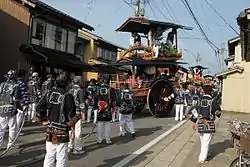 Murakami Taisai Festival | |
 Flag  Seal | |
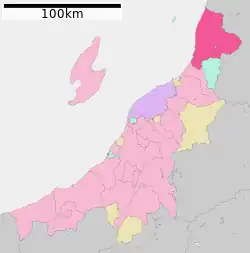 Location of Murakami in Niigata Prefecture | |
 Murakami | |
| Coordinates: 38°13′26.4″N 139°28′48″E | |
| Country | |
| Region | Chūbu (Kōshin'etsu) (Hokuriku) |
| Prefecture | Niigata |
| Area | |
| • Total | 1,174.26 km2 (453.38 sq mi) |
| Population (December 1, 2020) | |
| • Total | 58,300 |
| • Density | 50/km2 (130/sq mi) |
| Time zone | UTC+9 (Japan Standard Time) |
| Phone number | 0254-53-2111 |
| Address | 1-1, Sannochō, Murakami-shi, Niigata-ken 958-8501 |
| Climate | Cfa |
| Website | Official website |
| Symbols | |
| Bird | Spizaetus nipalensis |
| Flower | Rosa rugosa |
| Tree | Fagus crenata |
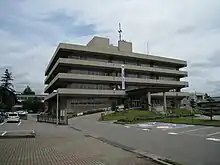
Geography
Murakami is northernmost and easternmost city of Niigata prefecture, and is located on the Sea of Japan coast, bordered by Yamagata Prefecture to the north and east. In terms of area, it is the largest in the prefecture.
Surrounding municipalities
Climate
Murakami has a humid climate (Köppen Cfa) characterized by warm, wet summers and cold winters with heavy snowfall. The average annual temperature in Murakami is 12.8 °C (55.0 °F). The average annual rainfall is 2,215.0 mm (87.20 in) with September as the wettest month. The temperatures are highest on average in August, at around 25.5 °C (77.9 °F), and lowest in January, at around 1.7 °C (35.1 °F).[2]
| Climate data for Murakami (1991−2020 normals, extremes 1978−present) | |||||||||||||
|---|---|---|---|---|---|---|---|---|---|---|---|---|---|
| Month | Jan | Feb | Mar | Apr | May | Jun | Jul | Aug | Sep | Oct | Nov | Dec | Year |
| Record high °C (°F) | 14.8 (58.6) |
21.5 (70.7) |
23.1 (73.6) |
30.3 (86.5) |
32.1 (89.8) |
34.6 (94.3) |
37.2 (99.0) |
39.9 (103.8) |
38.4 (101.1) |
33.7 (92.7) |
25.8 (78.4) |
20.9 (69.6) |
39.9 (103.8) |
| Average high °C (°F) | 4.7 (40.5) |
5.4 (41.7) |
9.4 (48.9) |
15.7 (60.3) |
21.5 (70.7) |
25.2 (77.4) |
28.5 (83.3) |
30.5 (86.9) |
26.4 (79.5) |
20.2 (68.4) |
13.8 (56.8) |
7.8 (46.0) |
17.4 (63.4) |
| Daily mean °C (°F) | 1.7 (35.1) |
1.8 (35.2) |
4.7 (40.5) |
10.2 (50.4) |
15.9 (60.6) |
20.3 (68.5) |
24.1 (75.4) |
25.5 (77.9) |
21.3 (70.3) |
15.1 (59.2) |
9.2 (48.6) |
4.2 (39.6) |
12.8 (55.1) |
| Average low °C (°F) | −1.0 (30.2) |
−1.4 (29.5) |
0.4 (32.7) |
4.7 (40.5) |
10.7 (51.3) |
15.8 (60.4) |
20.4 (68.7) |
21.3 (70.3) |
17.1 (62.8) |
10.6 (51.1) |
5.0 (41.0) |
1.0 (33.8) |
8.7 (47.7) |
| Record low °C (°F) | −9.6 (14.7) |
−11.0 (12.2) |
−7.5 (18.5) |
−5.8 (21.6) |
2.2 (36.0) |
6.6 (43.9) |
10.3 (50.5) |
12.3 (54.1) |
6.2 (43.2) |
1.6 (34.9) |
−2.3 (27.9) |
−6.9 (19.6) |
−11.0 (12.2) |
| Average precipitation mm (inches) | 220.9 (8.70) |
147.4 (5.80) |
133.9 (5.27) |
115.4 (4.54) |
128.5 (5.06) |
132.1 (5.20) |
240.6 (9.47) |
180.2 (7.09) |
184.5 (7.26) |
202.4 (7.97) |
246.8 (9.72) |
255.0 (10.04) |
2,215 (87.20) |
| Average precipitation days (≥ 1.0 mm) | 25.8 | 21.4 | 18.5 | 13.2 | 12.2 | 10.5 | 13.6 | 11.2 | 13.8 | 15.8 | 19.6 | 24.4 | 200 |
| Mean monthly sunshine hours | 33.2 | 55.8 | 112.7 | 165.3 | 193.0 | 179.5 | 158.2 | 201.2 | 147.2 | 131.3 | 80.8 | 41.2 | 1,499.4 |
| Source: Japan Meteorological Agency[3][2] | |||||||||||||
Demographics
Per Japanese census data,[4] the population of Murakami has declined steadily over the past 70 years.
| Year | Pop. | ±% |
|---|---|---|
| 1920 | 65,589 | — |
| 1930 | 71,714 | +9.3% |
| 1940 | 74,324 | +3.6% |
| 1950 | 92,840 | +24.9% |
| 1960 | 92,322 | −0.6% |
| 1970 | 83,107 | −10.0% |
| 1980 | 80,206 | −3.5% |
| 1990 | 76,511 | −4.6% |
| 2000 | 73,902 | −3.4% |
| 2010 | 66,427 | −10.1% |
| 2020 | 58,300 | −12.2% |
History
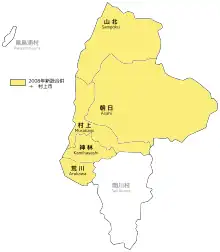
The area of present-day Murakami was part of ancient Echigo Province. Murakami developed as a port and a castle town for the Murakami Domain under the Tokugawa shogunate in the Edo period. Even today, the downtown area shows the influence of its past existence as a residence of samurai and merchants. Following the Meiji restoration, the area was organized as part of Iwafune District, Niigata, and the town of Murakami was established with the establishment of the modern municipalities system on April 1, 1889. Murakami was raised to city status on March 31, 1954. On April 1, 2008, the towns of Arakawa and Sanpoku and the villages of Asahi and Kamihayashi (all from Iwafune District) were merged into Murakami.
Government
Murakami has a mayor-council form of government with a directly elected mayor and a unicameral city legislature of 26 members. Murakami, collectively with the villages of Sekikawa and Awashimaura contributes two members to the Niigata Prefectural Assembly. In terms of national politics, the city is part of Niigata 3rd district of the lower house of the Diet of Japan.
Education
Murakami has 21 public elementary schools and seven public middle schools operated by the city government. There is one public middle school and three public high schools operated by the Niigata Prefectural Board of Education. The prefecture also operates one special education school.
Transportation
Railway
- Sakamachi - Hirabayashi - Iwafunemachi - Murakami - Majima - Echigo-Hayakawa - Kuwagawa - Imagawa - Echigo-Kangawa - Gatsugi - Fuya
Highway
 Nihonkai-Tōhoku Expressway – Kamihayashi-Iwafune IC, Murakami-Senami Onsen IC, Murakami-Yamaberi IC, Asahi-Miomote IC, Asahi-Mahoroba IC
Nihonkai-Tōhoku Expressway – Kamihayashi-Iwafune IC, Murakami-Senami Onsen IC, Murakami-Yamaberi IC, Asahi-Miomote IC, Asahi-Mahoroba IC National Route 7
National Route 7 National Route 113
National Route 113 National Route 290
National Route 290 National Route 345
National Route 345
Sister city relations
 - Sabae in Fukui Prefecture, Japan.
- Sabae in Fukui Prefecture, Japan.
Local attractions
Famous products of Murakami are tea (Murakami is the northernmost tea-growing spot in Japan), salmon, and Murakami beef. The city is also a tourist spot because of famous Senami Onsen and as a jumping off point to Awashima Island.
 Salmon in Murakami
Salmon in Murakami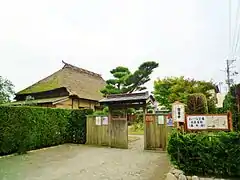 Samurai residence
Samurai residence![Sasagawa-nagare [ja]](../I/Maoroshi%252C_Murakami%252C_Niigata_Prefecture_958-0001%252C_Japan_-_panoramio_(1).jpg.webp) Sasagawa-nagare
Sasagawa-nagare![Senami Beach [ja]](../I/Senami_Beach_01.jpg.webp) Senami Beach
Senami Beach
National Historic Sites
- Yamamoto Site
- Murakami Castle ruins
- Hirabayashi Castle ruins
Festivals
Murakami Taisai, a traditional regional festival, has been held in the downtown area on July 6 and 7, annually, since 1868.
References
- Murakami City official statistics(in Japanese)
- 気象庁 / 平年値(年・月ごとの値). JMA. Retrieved March 24, 2022.
- 観測史上1~10位の値(年間を通じての値). JMA. Retrieved March 24, 2022.
- Murakami population statistics
External links
 Media related to Murakami, Niigata at Wikimedia Commons
Media related to Murakami, Niigata at Wikimedia Commons- Official Website (in Japanese)
- Murakami City Tourism Association (in English)
- Discover Uetsu (in English)